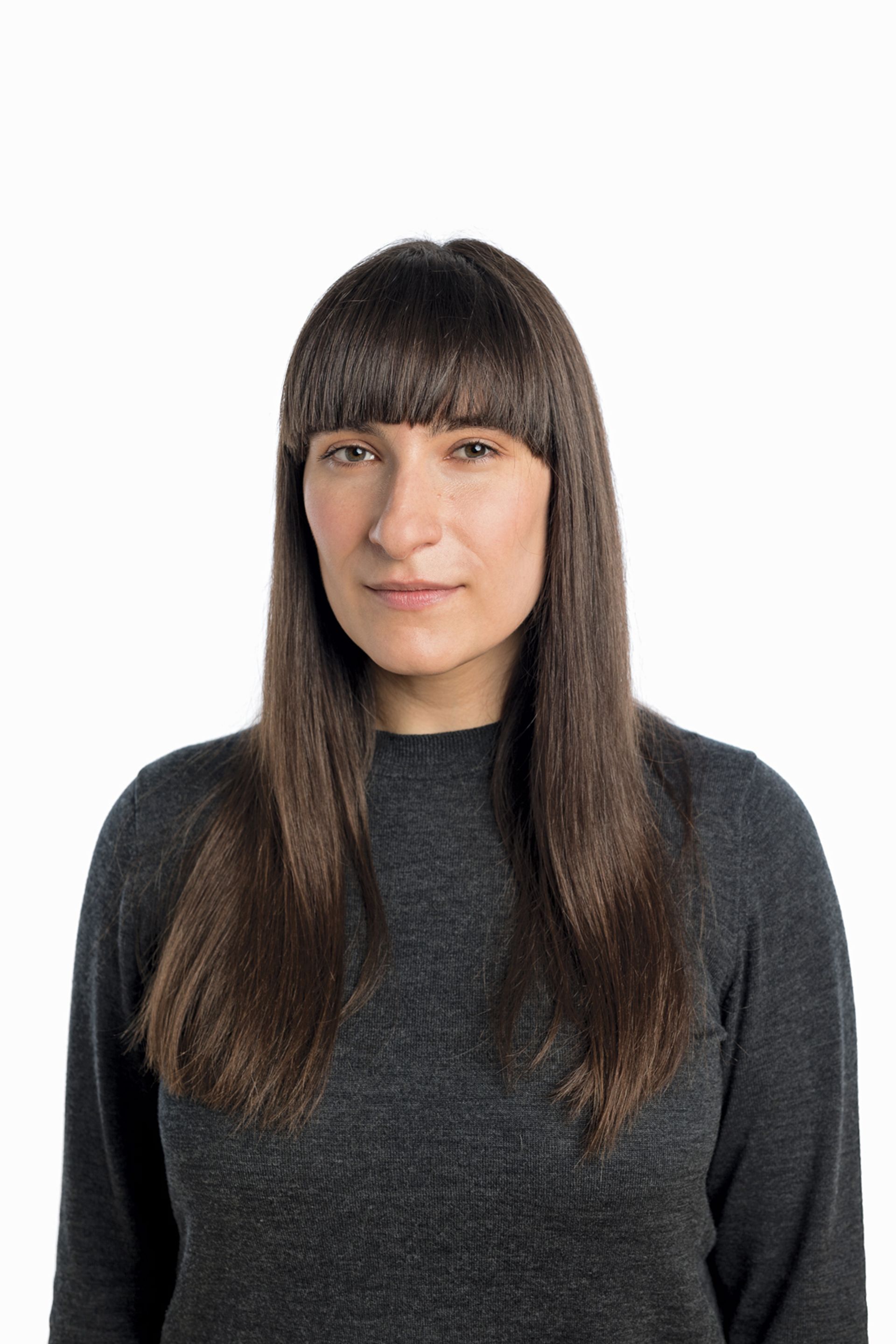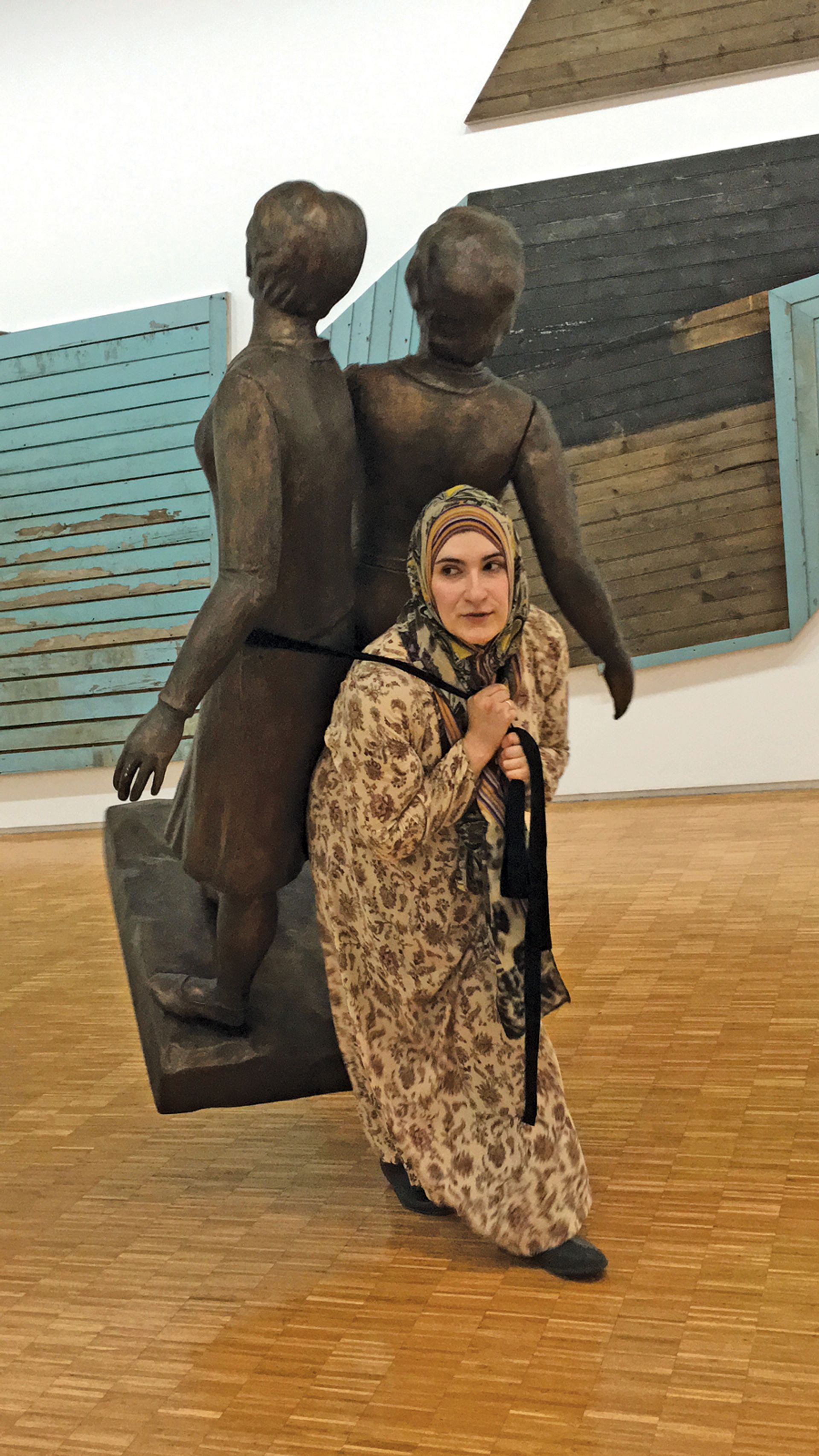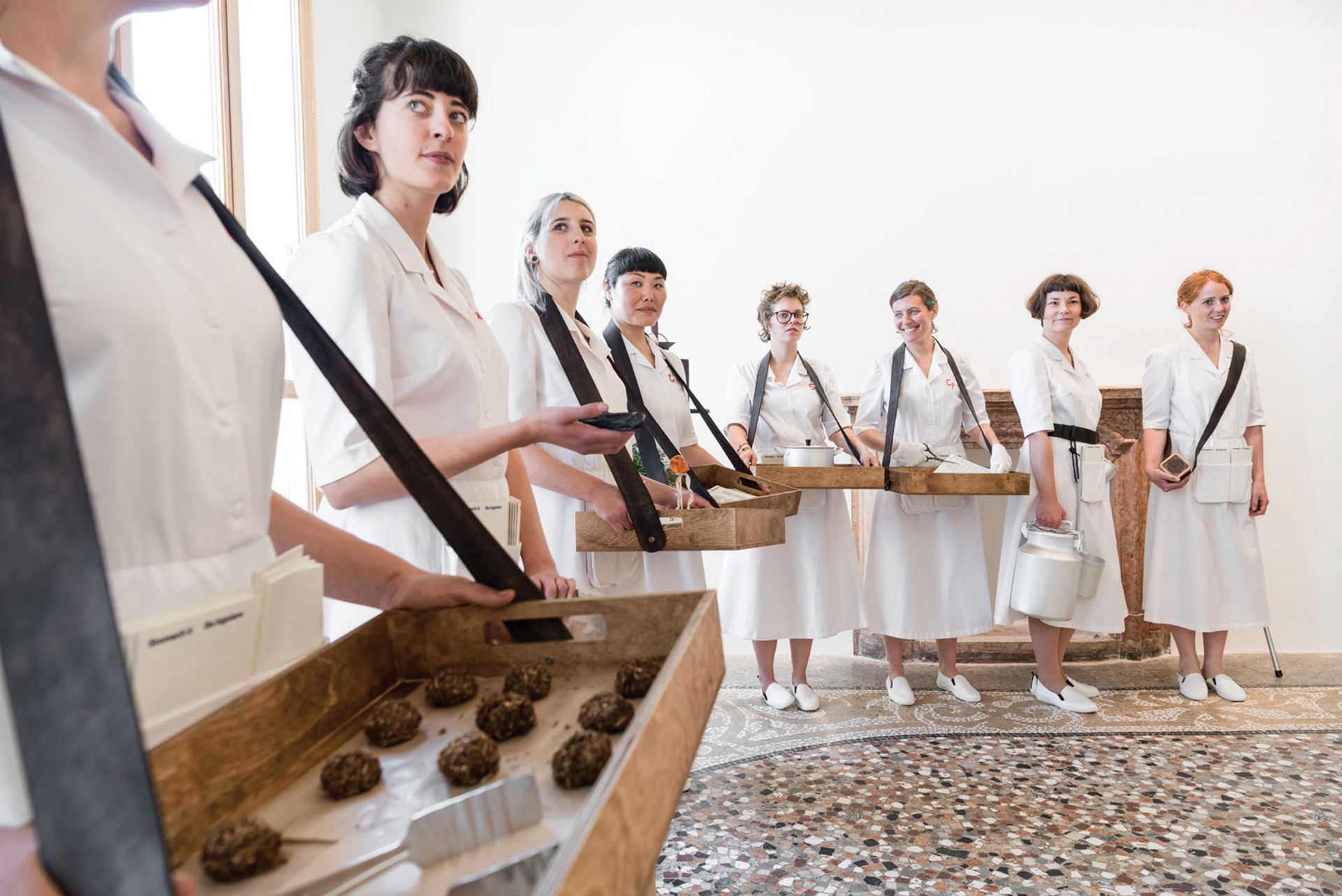Taus Makhacheva first attracted widespread attention at the 2017 Venice Biennale, where her film Tightrope (2015) was one of the most talked-about works in Christine Macel’s Viva Arte Viva exhibition. The Russian-Dagestani artist is best known for making films and performative works examining the tensions between tradition and modernity, and notions of truth, assimilation and cultural authenticity following the Sovietisation of her native Dagestan. The film showed a tightrope walker carrying 61 works copied from the Dagestan Museum of Fine Art collection across a perilous canyon high in the Caucasus Mountains. Other works have involved the artist rolling herself in a Dagestani rug; driving an SUV covered in old Soviet fur coats among the boy racers of the Dagestani capital Makhachkala, and filming herself in the role of Super Taus, a female superhero clad in traditional Dagestani day wear who performs extraordinary feats of strength while passers-by look on in amazement.
This summer, Makhacheva is presenting ASMR Spa, her most ambitious work to date, for the Liverpool Biennial. This takes the form of a ruin-like sculptural installation that also functions as a spa that treats the visitor as “a sculptural subject”. Not only will ASMR Spa offer full facials using a specially made range of beauty products but it will also incorporate videos using ASMR (autonomous sensory meridian response) techniques, which promise to deliver a heightened experience combining the intellectual, physical and emotional.

In Tightrope (2015), Rasul Abakarov, a tightrope walker, crossed a canyon in the Caucausus Mountains carrying copies of works from the Dagestani Museum of Fine Art Courtesy Taus Makhacheva
The Art Newspaper: ASMR Spa in Liverpool sounds very intriguing and complex. What’s the thinking behind it?
Taus Makhacheva: One of the key things I was thinking about was how we are all seduced by artworks and the experiences we gather from seeing them. It can be a very multisensory experience—intellectual, emotional and physical—if the work is good enough. And it was those kind of experiences that I’m trying to recreate with this whole massive build-up.
The space where the treatments take place is like a gigantic face made of Greek sculpture, which has all been broken up and which configures into this broken, destroyed face. I worked with Alexander Kutovoi, a fantastic sculptor from Ukraine, because I had never made a sculptural installation before. There’s one treatment bench with broken sculptural elements and twice a week visitors can make an appointment to be treated by a performer who is a blend of a beautician and a restorer; you become this restored artwork, in a way. As they give the treatment the performer-beauticians are narrating a script written by David McDermott, a writer based in Liverpool. This tells stories of disappeared and damaged works, and it also talks about mirror-touch synesthesia, an extreme mirroring process where some people physically feel pain when they see other people being hurt. I found out about this when I was doing research in the psychology department at Goldsmiths. Apparently some people even have it with objects and it got me thinking about how somebody with this condition would feel if they saw, say, a painting being slashed.
Is the idea that the visitor feels empathy with these unfortunate works?
Yes, even to the extent of them feeling like they are actually becoming one. The practitioner also talks about how the products they are using are made up from actual works, so the visitor is both hearing about and literally absorbing broken pieces of art. The facial products have been developed by 22/11 Cosmetics, a specialist brand in Moscow, and are based on six processes of making works. The first stage is a cleansing cream made from clay; then there’s a toner and a scrub containing marble particles from ground-down sculptures. Then there’s a massage oil with wooden essences so that we think about a wooden sculpture, and then a plaster facemask that you literally peel off and leave an imprint of yourself like a cast; as time goes by there’ll be loads of faces left by previous visitors lying around. I’m particularly excited about the last stage that I call a painting in a tube, which is a cream made out of the blended elements of a painting. The main ingredients are linen and cotton extracts from the canvas mixed with linseed oil—what oil paint is made from—along with some pigment. So throughout the process you are becoming a sculpture and leaving with the painting moisturiser on your face. But I’m collaborating with professionals so these products are also actually good for you.
Will the products be for sale?
Yes, there will be a limited-edition signature sculptural facial set.
Where does the ASMR come in?
As well as the bench for the treatments there are two chairs and some more furniture with screens and headphones, so the same procedure is performed on an ASMR video that people can come in and experience.
So most visitors will have a virtual relationship with the broken works?
The whole piece started with my fascination with these ASMR videos, which are all about trying to create a one-to-one intimacy but completely through the membrane of the screen. So you get this very intimate experience of personal attention. They are mostly done with 3D microphones and because of the technology it actually feels like you are being physically cared for. It is also important for the piece that the spa is located in Blackburne House, a charitable education centre for local and often vulnerable women. It’s a place where you try to rebuild yourself and this was one of the inspirations for the spa; you are lying on this broken face and being repaired through this facial, either literally or virtually.
Tightrope involved the precarious fate of works of art but within a more specific context. Unlike your Liverpool Biennial piece, your past work dealt much more specifically with your cultural roots in Dagestan. Is this now less important?
I don't think that the undercurrents that were in my work before have been erased; they are just changing shape. The geographies of artistic production don't interest me so much any more; it’s thematic considerations rather than geographic borders that excite me now. Why, for example, can’t acquisition committees be dedicated to space exploration or wormholes, or works exploring landscapes, seas or mountains, rather than always being organised according to geographic considerations? I guess that’s the shift that’s happening at the moment; it’s no longer the locality that I’m interested in, but the different phenomena that I experience, observe or have conversations about. I love wit in other artists’ work when you look at something and it can be culturally, humanly, geographically specific, but there’s also a wider theme. I think that was why Tightrope proved to be of such interest to people because it was so recognisable; museum directors would come up and say “Oh my God, it’s like me trying to fundraise for my next show!”
Was ASMR Spa made with a wider Liverpool audience in mind?
Absolutely. I explored the culture deeply, including having my hair done at the Voodou salon and making many research visits to spas. It was also why I wanted David to write the script, as he’s deliberately using a language that’s very different from the usual art-crowd language. Hopefully, through the seductive prospect of improving their looks, people will be seduced into learning of the history and the destruction of works of art, even if they are living outside these stories and these experiences, and don’t know about the biennial at all.

Makhacheva’s work came to international attention while she was still a student Ivan Erofeev for Garage Museum of Contemporary Art
Biography
Background: Born in 1983 in Moscow to a medical doctor father and an art historian mother, Taus Makhacheva is descended from the Avars, the predominant ethnic group in Dagestan. Her grandfather on her mother’s side was the poet Rasul Gamzatov and her grandmother was the first director of the Dagestan Museum of Fine Arts, from where the pictures used in Tightrope were copied. Makhacheva lives and works between Moscow, Dagestan and London.
Education: A cousin studying fashion journalism in London inspired Makhacheva to apply for a foundation course in photography at the London College of Communication. Between 2003 and 2007 she took a BA in fine art at Goldsmiths, University of London and after a year studying at Moscow’s Institute of Contemporary Art, she returned to London to take an MA in fine art at the Royal College of Art between 2011 and 2013.
Milestones: While she was still studying Makhacheva was already showing internationally: in the Moscow Biennale in 2011, the Liverpool Biennial of 2012 and the Sharjah Biennial in 2013. More recent exhibitions include at Moscow’s Garage Museum of Contemporary Art in 2014, the Kiev Biennial in Ukraine and Moscow Biennale in 2015 and, in 2016, at the Centre Pompidou, Paris and the Shanghai Biennale. Then there was the widely acclaimed showing of Tightrope (2015) at the Venice Biennale in 2017—as well as, at the same event, Baida (2017) and Stomach It (2017). She is represented by Narrative Projects, London.

Super Taus Untitled 2 (2016) Malika Alieva
Three key works:
Tightrope (2015)
Rasul Abakarov, from the fifth generation of a Dagestani tightrope dynasty, crosses a canyon in the Caucasus Mountains using works of art instead of a balancing pole before placing them in a structure that resembles a museum storage unit. The works are copies from the collection of the Dagestani Museum of Fine Art and, according to Makhacheva, encapsulate the history of 20th-century art in the region. There’s even a picture of her famous poet grandfather, Rasul Gamzatov, meeting Che Guevara. “The work questions how we collect things and the general situation with museums around the world—their constant balancing and the constant precarity of existence for anyone involved in any creative field,” she says. “It is also about the doubts that you have when you make a work. Will it make it across the tightrope or not?”
Super Taus Untitled 2 (2016)
Makhacheva assumes her alter ego Super Taus as she searches for a home for a monument to Maria Korkmasova and Khamisat Abdulaeva, the two Dagestani museum attendants who saved a Rodchenko canvas by seizing it from a knife-wielding robber in the early 1990s. Makhacheva developed Super Taus “in recognition and homage to all my female relatives who perform heroic tasks in their daily lives”, she says. Dressed in the cheapest daily wear of women living in northern Dagestan, Super Taus has extraordinary strength, walking between the Dagestan capital Makhachkala, Moscow and Paris with the 300kg sculpture on her back. “Super Taus is a work in progress; right now she’s thinking about creating a superhero coalition,” says her creator.
Stomach It: menu and performance (2017)
In this work commissioned by V-A-C Foundation for the Venice Biennale in 2017 eight servers offer guests dishes on the theme of “the politics of food”. These consisted of two carrots wrapped in edible paper printed with a poem by Vladimir Mayakovsky; inedible bread made from flour of dried leaves and hay; a dish consisting of a smell developed by a perfumer to imitate the aroma of fatty soup; a loudspeaker on a plate emitting the sound of hungry stomachs; and lollipops in the shape of Lenin’s head. “For me food is the quickest way of accessing different points within the intellectual and the emotional,” Makhacheva says. “All these dishes led to a kind of kinesthetic time travel which evoked the pain of hunger experienced by the millions who suffered starvation and death because of Soviet policies, especially in the 1950s in Ukraine and the Caucasus.”

Stomach It: menu and performance (2017) Taus Makhacheva, Photo: Andrea Penisto

